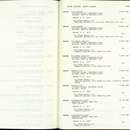Biology
provided by Arkive
Stephen's lorikeet is a generalist feeder whose diet includes nectar, pollen and fruit from a wide variety of plants, from canopy level in coconut palms to ground level shrubs, as well as the occasional insect (2) (4).
Nothing is known of this bird's reproductive biology other than specimens with developing gonads were collected in April, and a female had an enlarged ovary in May (2).
Conservation
provided by Arkive
Safeguarding Stephen's lorikeet appears to rely on ensuring the integrity of Henderson Island (5) and, in 1988, the uninhabited island was designated a World Heritage Site (4). It has been advocated that further research into the impact the Pacific rat has on the bird should be conducted and, potentially, rat eradication should be considered (4) (5). The possibility of rat eradication has been investigated and deemed feasible but is thought to be difficult because of the island's isolation (4).
Description
provided by Arkive
Stephen's lorikeet is a colourful red-and-green bird with a golden-yellow bill and eyes. Upperparts are dark green shading to golden-yellow at the tip of the wedge-shaped tail (2) (4). The cheeks and underparts are vivid red, with a dark purple patch on the belly and a broken breast band across the chest that is green at the sides and purple in the centre (2) (4).
Habitat
provided by Arkive
Found in native forest, favouring forest edge, and in coconut palms along the shoreline (4).
Range
provided by Arkive
Restricted to Henderson Island in the Pitcairn Group, a small uninhabited, raised-reef island in the south-central Pacific Ocean (4).
Status
provided by Arkive
Classified as Vulnerable (VU) on the IUCN Red List 2006 (1) and listed on Appendix II of CITES (3).
Threats
provided by Arkive
Stephen's lorikeet is considered vulnerable to extinction because it has such a restricted range, where it is at risk from the accidental introduction of alien species. Fortunately, this bird appears to have adapted well to the presence of the only introduced predator on Henderson Island to date, the Pacific rat (Rattus exulans) (4). However, the introduction of a more aggressive predator, such as black rats (Rattus rattus), could be devastating and introduced diseases such as avian malaria and pox pose another potential threat (2) (4). Additionally, the introduction of exotic plant species could have a serious impact on native vegetation and diminish essential feeding and nesting habitat for this species (4). As long as no human settlement on the island is attempted, Stephen's lorikeet should remain fairly secure, but the island's vulnerability was exposed in 1982-1983 when a millionaire sought to make it his home (2) (5).
Stephen's lorikeet
provided by wikipedia EN
Stephen's lorikeet (Vini stepheni), also known as the Henderson lorikeet or the Henderson Island Lorikeet, is a species of parrot in the family Psittaculidae. It is endemic to Henderson Island in the Pitcairn Islands of the South Pacific.
Its natural habitat is subtropical or tropical moist lowland forest. It is threatened by habitat loss and the accidental introduction of predators to the island.[2]
Description
The lorikeets are 19 cm (7.5 in) in length and weigh 42–55 g (1.5–1.9 oz).
Adults are green on the upper side, with a green occiput and crown. The green color turns into a yellow-green at the base and tail. They have a green underwings, with a green band across the chest that varies in appearance. Their breast is red in color, and turns purple towards their abdomen and thighs. They have a deep orange beak with yellow or orange eyes.[3]
Juvenile Stephen's lorikeets have green underparts with purple or red marks on their throats and abdomens. Their tail tends to be a dark green. They have brown beaks and eyes.[3]
The calls emitted while feeding are soft and twittering. The call made while in flight are louder.[3]
Behavior and ecology
The lorikeets are hard to spot in dense foliage. They are generally found in small groups or flocks. They are known to travel between the inland foliage and coastal palms to feed on coconuts.[3]
Diet
The diet of the birds is composed of nectar, pollen, fruits, and butterfly and moth larvae. The majority of nectar eaten by the lorikeets comes from the flowers of Scaevola sericea and Timonius polygamus.[3][4]
Reproduction
Their breeding season is thought to be around April or the start of May.[3]
Threats
The lorikeets are assessed as vulnerable by the IUCN. They are thought to have a stable population of 720-1820 individuals. Due to their extremely limited range, the main threat to the survival of the lorikeets is the accidental introduction of predators to Henderson Island and habitat loss due to deforestation or natural disasters. They, however, seem to have adjusted to the introduction of at least one invasive predator, the Polynesian rat. There has been an unsuccessful attempt to eradicate invasive rodents from Henderson Island.[3][5]
Distribution and habitat
The lorikeet is endemic to Henderson Island in the Pitcairn Islands. It inhabits coconut palms as well as the dense forest on the interior of the island.[3]
References

- license
- cc-by-sa-3.0
- copyright
- Wikipedia authors and editors
Stephen's lorikeet: Brief Summary
provided by wikipedia EN
Stephen's lorikeet (Vini stepheni), also known as the Henderson lorikeet or the Henderson Island Lorikeet, is a species of parrot in the family Psittaculidae. It is endemic to Henderson Island in the Pitcairn Islands of the South Pacific.
Its natural habitat is subtropical or tropical moist lowland forest. It is threatened by habitat loss and the accidental introduction of predators to the island.
- license
- cc-by-sa-3.0
- copyright
- Wikipedia authors and editors

